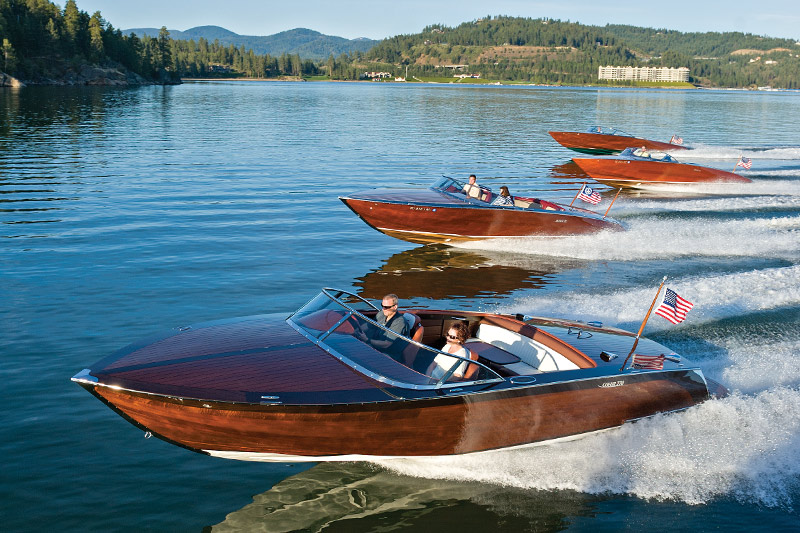
 When one thinks of Pacific Northwest boating, images of the green and gold hills of the San Juan Islands or a Mt. Rainier backdrop tend to prevail. However, east of the Cascades lies the waterways of Idaho’s panhandle, a series of lakes and rivers carved out of the rugged landscape teaming with boating promise. Lakes, among the largest in the contiguous United States, are central to the Idaho boating experience. Lake Coeur d’Alene may be the most well-known thanks to the city of Coeur d’Alene and the accompanying resorts, golf courses, and thriving tourism trade. To the north, the state’s largest lake, Lake Pend Oreille (pronounced pond oh-RAY), is less developed, with much of the shoreline protected under the auspices of the Coeur d’Alene National Forest. Priest Lake, which teases our border with Canada, is another boating destination that inevitably comes up during a chat with a knowledgeable local.
When one thinks of Pacific Northwest boating, images of the green and gold hills of the San Juan Islands or a Mt. Rainier backdrop tend to prevail. However, east of the Cascades lies the waterways of Idaho’s panhandle, a series of lakes and rivers carved out of the rugged landscape teaming with boating promise. Lakes, among the largest in the contiguous United States, are central to the Idaho boating experience. Lake Coeur d’Alene may be the most well-known thanks to the city of Coeur d’Alene and the accompanying resorts, golf courses, and thriving tourism trade. To the north, the state’s largest lake, Lake Pend Oreille (pronounced pond oh-RAY), is less developed, with much of the shoreline protected under the auspices of the Coeur d’Alene National Forest. Priest Lake, which teases our border with Canada, is another boating destination that inevitably comes up during a chat with a knowledgeable local.
But Idaho is not just a pretty face. Some of the nation’s best boat builders and most successful boating businesses are thriving in Idaho, and a boating culture all its own has emerged. Iconic custom wood builds from Idaho manufacturers like Coeur d’Alene Custom Wood Boats, owned by the Hagadone Marine Group, and Stancraft, based in Hayden, Idaho, are defining what it means to boat the Idaho way.
The history of boating in Idaho dates back to prehistory as Native Americans migrated to North America during the wane of the last great Ice Age. Over the millennia, tribes began to form; Kootenai, Kalispel, Coeur d’Alene, Palouse, Nez Perce, Shoshone-Bannock, and Northern Paiute. These tribes commonly used canoes to traverse rivers like the Columbia or Snake and supplement their diets fishing the salmon runs, which were considerable before being depleted in modern times.

Right: The entrance to the Boardwalk Marina, owned by the Hagadone Marine Group in Coeur d’Alene, features a vaulted walkway for pedestrians who can walk around the entire marina. The Coeur d’Alene Resort is also located inside the entrance.
With the pioneer settling of the West, towns like Coeur d’Alene began to form. Coeur d’Alene was founded in 1878 and became a magnet for silver miners. The boom helped transform the area into a bustling economy, and an era of steamships dominated the region from the 1880s to the 1930s. It is widely believed that more steamboats operated on Lake Coeur d’Alene during this time than on any other lake west of the Great Lakes. The colorful steamboat culture is full of fascinating stories, such as the rivalry between the two steamboats Idaho and Boneta. The rivalry ended when the Idaho rammed the Boneta “in an accident” and sank her.
Ultimately, the advance of the railroads ended the era of the Idaho steamship. At least five steamboats were deliberately sunk off Stevens Point in Lake Coeur d’Alene, the last of the fleet. The area is known locally as the Steamboat Graveyard. The rusty remains of old boilers and the like from steamboats can still be found if one knows where to look.
The Idaho boat culture we know today retains much of the classic look from the 1930s and 40s, but with a modern flair. A visit to the annual Coeur d’Alene Classic Boat Show, held in late August, will give the curious a glimpse of Idaho’s finest. However, my takeaway from a factory visit with Jim Brown, the head of the wood shop of Coeur d’Alene Custom Wood Boats, is not that Idaho builders are trying to recapture the magic of the past. Today’s wood boats emphasize the modern with cutting edge and novel build methods. In short, these ain’t your grandad’s Chris Crafts.
Jim Brown shakes my hand. It’s a chilly fall day in Coeur d’Alene and we promptly make our way to the warmth of the office of Coeur d’Alene Custom Wood Boats. Pictures of the company’s prize builds cover the wall, and a vintage wood, four-cylinder hydroplane sits in the middle of the reception area like a museum piece. The hydroplane belonged to local Jim McGoldrick, who raced it extensively back in the day.
“This hydroplane hasn’t been out on the water in years,” says Brown fondly. “She’s just something to drool over. I have huge respect for the boat builders of the past. They were skilled craftsmen.” We don’t take long to start talking shop.
“We (the Resort Boat Shop owned by the Hagadone Marine Group) are pretty much a full-service marina. We do everything from new boat sales through service, storage, and, of course, the best part of it, the custom wooden boats.” The Hagadone Marine Group is a boating industry giant of the area and regularly places as a top boat dealer of the country. But as far as Jim Brown is concerned, the stars of the show are the custom wood boats.

Right: A formation of builds from Custom underway on Lake Coeur d’Alene. Although aesthetically the boats are reminiscent of builds from the 1930s or ‘40s, modern techniques mean fewer vulnerabilities in the structure and greater longevity.
“I’m sure I’m a little biased,” Brown chuckles. “This journey Coeur d’Alene Custom Wood Boats is on right now started around 2001. Ownership of the boat shop, this facility, was sold to Hagadone Marine Group. All the employees stayed, including me. That’s where we started off as the Hagadone Resort Boat Shop, and we started to develop a line of wood boats. We started calling our boats Custom Wood Boats.” The goal was to blend the vintage appeal of wood with modern, never attempted building techniques.
“The goal is to make wood boats that require less maintenance and provide more longevity. With traditional wooden boat building, each hull frame is going to have a joint that is a point of weakness,” says Brown. For example, the sheer of a boat hull travels down to the chine where there’s a joint. In Custom’s cold molds, they eliminated all those joints. They use a laminated bent-horseshoe frame from shear to shear, no joints involved.
“There are other places where we’ve added wood to create a sharper corner because you can’t create that by bending wood. There’s no screws, no joints, no surface plugs, no nothing. On traditional wood boats, it’s not a matter of if a plug is going to be a trouble area, it’s when,” says Brown. This process is much more labor intensive and time consuming, but the results are boats that last longer and require just a basic spar varnish for maintenance.
“Our boats should outlive the old ones by many times. They should be around four or five generations or more, instead of three. The trick is to not abuse the wood. Get the boat out of the sun, and use the varnish like how we use sunscreen. We don’t want to do more maintenance than we have to. We don’t want to sand down the boat, because ultimately that means less boat,” says Brown.
Custom Wood Boats is a small builder with a typical year yielding one or two builds. The goal is not to create a production line, but stay true to the company’s “custom” namesake. “We don’t want to build the same boat over and over again,” says Brown. “But these boats are meant to be taken out and used. These boats have lots of horsepower and the handling is amazing. One of our 27’ designs has a 5.5 Mercury racing engine with dual external hydraulic steering. Very light touch. That boat, you can take it out and throttle it up, cut real hard, and it’ll bank and cut like a good skier. It’s meant to run, play!”

hydraulics and state-of-the-art equipment.
Brown and his team’s talents were eventually put to the test by none other than Mr. Hagadone himself with the 60’ one-of-a-kind sailing yacht, Sizzler.
“Sizzler was a phenomenal opportunity for a wooden builder like me,” says Brown. The entire shop was converted to accommodate the building of the all-wood hull designed by English naval architect Tony Castro. Sizzler was designed to be the ultimate daysailor, complete with a large entertainment cockpit and no overnight accommodations below. Built with a lifting bulb keel (from 11’ to 7’), dual helms, and rigging for a large jibe and Code 0 spinnaker, Sizzler also is equipped with hydraulic winches and below-deck line management systems to make single handing easy. Her cold-molded hull features four layers of wood and is an inch and a quarter thick.
“She is a really fun ride with a great big cockpit and a lot of sail area for our lighter winds,” says Brown. Although the end result is stunning, the process of making Sizzler is a saga of rolled-up sleeves and blazed trails.
“The owner’s vision gave us plenty of challenges,” says Brown. “For example, he wanted to see the lights and darks of the wood of the hull and not have it painted over. We wanted to use a translucent finish, but nobody thought it could be done. We couldn’t get a contract from anybody, so we did just did it ourselves. She just glows.” Brown’s team also plumbed all the components themselves, both with wood and high-gloss carbon fiber.

Right: This house on the lake is also a channel marker.
The team launched Sizzler in 2007. Flash forward 10 years to my visit, and Sizzler is on the hard for her seasonal winterization at the newly opened Hagadone property on Blackwell Island. Brown offers to give me the tour, and I eagerly follow him in my car. The property, opened in the spring of 2017, is an expansion for the company that includes a full-service yard, marina, brokerage, and new shop for Custom. Brown and his co-workers will be moving to the new facility soon, and they’ve already begun packing up the old location.
Sizzler’s mast is easy to spot and Brown punches the access code at the entrance gate. We ascend a flight of scaffolding stairs and then we’re in the expansive cockpit. The topside is completely clear of rigging thanks to the custom below-deck line management system, and a walk across the gorgeous deck is surreal for me, a sailor used to an obstacle course of blocks, lines, and stays.
Below, the interior is all about function, with a small galley and modest enclosed head. The forward area houses hydraulic machinery instead of a berth. Every square inch is customized, from the carbon fiber head to the aluminum and carbon fiber detailing.
“She’s just phenomenal,” Brown half whispers as we descend from the boat and I have to agree. We part ways and I take a stroll past the dozens, if not hundreds, of boats floating idly in their slips. Offshore, I see sailboats and power boats enjoying the clear fall day, free of the summertime tourist crowds. Just another day boating the Idaho way.


